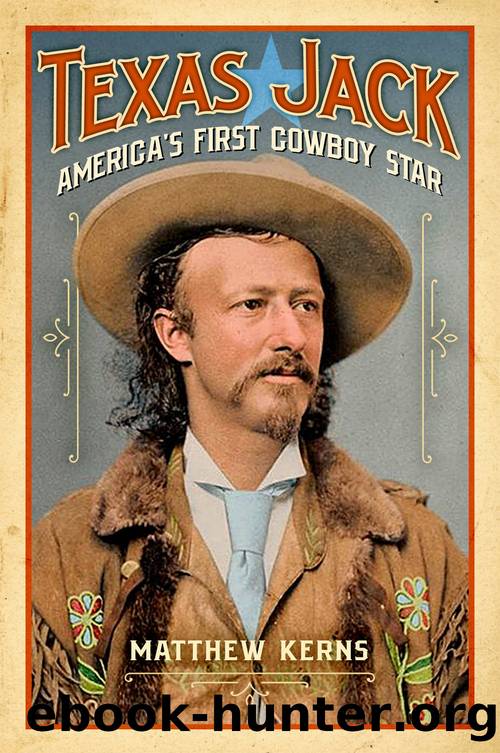Texas Jack by Matthew Kerns

Author:Matthew Kerns
Language: eng
Format: epub
Publisher: TwoDot
Published: 2021-03-02T00:00:00+00:00
âI had, moreover,â he continued, âheard the district spoken of as an excellent game-producing country; and pursuit of large game is to me a great delight: but it was less for any special design of hunting than for the satisfaction of my curiosity and the gratification of my sightseeing instincts that I really decided to attempt the trip.â4
Lord Dunraven was not alone in his desire to âsight seeâ in the young Yellowstone Park. Newly established by President Grant in 1872, the park was already attracting many such curious tourists. John Colterâan early mountain man and member of the famous Lewis and Clark Expeditionâhad become one of the first white men to enter the area in the winter of 1807 when he explored parts of the region on a trip to establish a trade partnership with the Crow (Apsáalooke) nation. After wandering unguided for months through a region with typical nighttime temperatures around -30 degrees Fahrenheit, Colter appeared at Fort Raymond, having traveled hundreds of miles. With his descriptions of steaming geysers, bubbling mud pots, and sulphurous springs, Colter was taken as a lunatic, and contemporary reports jokingly referred to his discovery as âColterâs Hell.â Modern assessments of Colterâs descriptions put his travels near present-day Cody, Wyoming.
In 1856 Jim Bridger reported seeing mountains of glass and yellow rocks, boiling springs, and spouting water in the same region, but was widely ignored due to his established reputation as a foremost âspinner of yarnsâ and the inaccessibility of the area. The beginning of the Civil War ensured that no explorations could be mounted until 1869, when the Cook-Folsom-Peterson Expedition followed the Yellowstone River to Yellowstone Lake.
A year later, Montanaâs surveyor-general, Henry Washburn, along with Nathaniel P. Langford and a detachment of the US Army, spent a month collecting specimens, naming landmarks, and exploring the area. The efforts of these men, as well as geological surveys by Ferdinand V. Hayden, paintings by Thomas Moran, and photographs by William Henry Jackson, led President Grant to sign The Act of Dedication declaring the area the nationâs first national park, after Congress agreed to withdraw the land from public auction.
Nathaniel âNational Parkâ Langford was appointed as superintendent of the park, but without the benefit of funding, staff, or salary, he was left without the means to spend time there. Over the course of five years as the parkâs superintendent, N. P. Langford managed to visit the Yellowstone area just twice. The creation of the park had piqued the curiosity of the nation, but the lack of resources meant that the land visitors traveled to see was truly wild. There were no maps, no permanent roads, and no protection from the threats of wild animals, treacherous terrain, and hostile Indians that might be encountered within the confines of the park.
âMy first act after making up my mind to undertake the trip to Geyserland,â wrote Dunraven, âwas to write my old friend, hunting companion and guide, Mr. John Omohundro, better known as Texas Jack, and endeavor to secure his services for the expedition.
Download
This site does not store any files on its server. We only index and link to content provided by other sites. Please contact the content providers to delete copyright contents if any and email us, we'll remove relevant links or contents immediately.
| Africa | Americas |
| Arctic & Antarctica | Asia |
| Australia & Oceania | Europe |
| Middle East | Russia |
| United States | World |
| Ancient Civilizations | Military |
| Historical Study & Educational Resources |
The Dawn of Everything by David Graeber & David Wengrow(1567)
The Bomber Mafia by Malcolm Gladwell(1519)
Facing the Mountain by Daniel James Brown(1428)
Submerged Prehistory by Benjamin Jonathan; & Clive Bonsall & Catriona Pickard & Anders Fischer(1375)
Tip Top by Bill James(1291)
Wandering in Strange Lands by Morgan Jerkins(1281)
Evil Geniuses: The Unmaking of America: A Recent History by Kurt Andersen(1269)
Red Roulette : An Insider's Story of Wealth, Power, Corruption, and Vengeance in Today's China (9781982156176) by Shum Desmond(1267)
The Way of Fire and Ice: The Living Tradition of Norse Paganism by Ryan Smith(1258)
Driving While Brown: Sheriff Joe Arpaio Versus the Latino Resistance by Terry Greene Sterling & Jude Joffe-Block(1230)
American Kompromat by Craig Unger(1213)
F*cking History by The Captain(1196)
It Was All a Lie by Stuart Stevens;(1191)
American Dreams by Unknown(1153)
Treasure Islands: Tax Havens and the Men who Stole the World by Nicholas Shaxson(1151)
Evil Geniuses by Kurt Andersen(1142)
White House Inc. by Dan Alexander(1122)
The First Conspiracy by Brad Meltzer & Josh Mensch(1075)
The Fifteen Biggest Lies about the Economy: And Everything Else the Right Doesn't Want You to Know about Taxes, Jobs, and Corporate America by Joshua Holland(1030)
